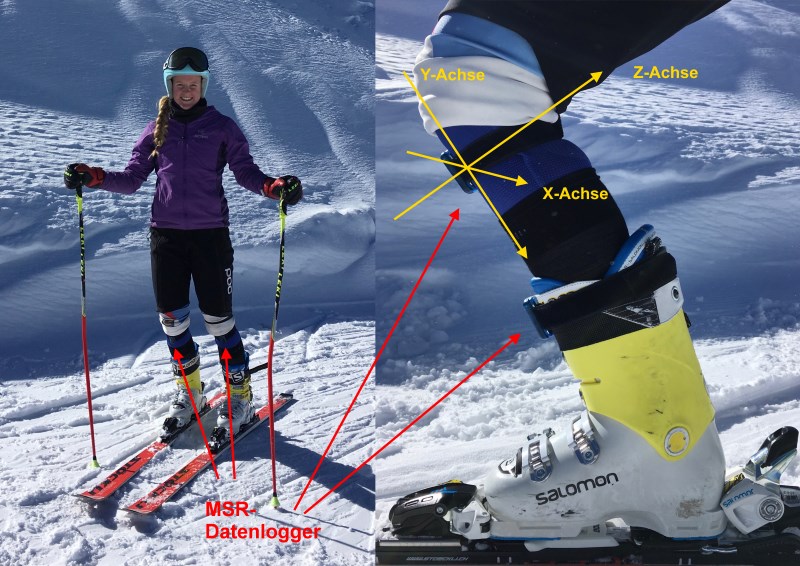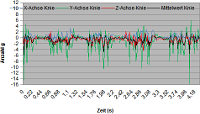Downhill racer Thea Waldleben measures g-forces using MSR Data Loggers
What is the level of the acceleration forces that impact upon
the knees of an alpine downhill racer while skiing? Thea Waldleben, the
current Swiss Junior Champion in the downhill event, addressed this
question in her “Maturaarbeit” (exam project). Using data loggers by the
MSR Electronics GmbH Company, the athlete analysed the stress on and
behavior of her knees while skiing under different conditions.
Thea Waldleben
 The downhill racer from Udligenswil (LU) trains in the women’s
squad of the Swiss-Ski Leistungszentrum Mitte and attends the
Sportmittelschule Engelberg. The racer, who is sponsored by ski
manufacturer Stöckli, achieved the following successes during the
2015/16 season, to name but a few:
The downhill racer from Udligenswil (LU) trains in the women’s
squad of the Swiss-Ski Leistungszentrum Mitte and attends the
Sportmittelschule Engelberg. The racer, who is sponsored by ski
manufacturer Stöckli, achieved the following successes during the
2015/16 season, to name but a few:
- Swiss Junior Downhill Champion U21
- Swiss Junior Downhill Champion U18
- Swiss Junior Super-G Champion U18
- Swiss Junior Combination Champion U18
Thea Waldleben, who is also successful in the Super-G discipline, trains in the women’s squad of the Leistungszentrum Mitte Ski Alpin of Swiss-Ski and attends the Schweizerische Sportmittelschule Engelberg (SSE). This educational establishment certified by Swiss Olympic has made a name for itself as a talent showcase for ambitious young athletes and has already produced prominent athletes, in particular in the field of alpine skiing, including Olympic gold medallist Dominique Gisin and World Cup medallist Wendy Holdener. Within the context of her “Maturaarbeit” (exam project), Thea Waldleben, who is sponsored by Swiss ski manufacturer Stöckli, asked herself which stresses her knees are exposed to while ski racing.
MSR165 mini data logger measures g-forces in all three axes
The athlete used the MSR165 data logger by Swiss measuring technology company MSR Electronics GmbH for her study. This data logger, which specializes in applications for recording oscillations, shocks and vibrations, is waterproof and merely the size of a thumb; therefore it is particularly suited for taking measurements on the body. The mini logger has a high-speed digital sensor, which is capable of taking up to 1600 measurements per second in the area of acceleration in all three axes. The MSR165 has a memory capacity of up to one billion measured values, depending on the configuration. By means of a sensor (with a working range of ±15 g or ±200 g), Ms. Waldleben was able to record which acceleration forces her knees are exposed to. As the housing of the data logger for the measurements on the body needed to have an even lower weight than the aluminum design housing of the MSR165 standard models, which are geared towards applications in industry, the ski racer was provided with a special design of the logger in a lighter SmartCase. The data loggers were attached by means of hook-and-loop tape directly below the knee joint on the tibial plateau, as well as above the ski boot.
Taking the measurements
 All measurements were taken while freestyle skiing without
cornering or in the gates when cornering. The different measuring blocks
took place on the same day within a short time period. The pistes were
selected according to their properties and condition with respect to
gradient and uniformity to ensure that the turns are comparable. Several
measurements were taken under different influencing factors to measure
and evaluate both the behavior of the athlete’s knees in the x, y and
z-axis and the average value. During the tests, the stress on the knee
while skiing with different types of skis (slalom and giant slalom),
under changed piste conditions and under the influence of the ski boot
hardness were analyzed. Ms. Waldleben worked with a frequency of 100
measurements per second in all three directions in order to identify
abruptly changing stresses on the knee.
All measurements were taken while freestyle skiing without
cornering or in the gates when cornering. The different measuring blocks
took place on the same day within a short time period. The pistes were
selected according to their properties and condition with respect to
gradient and uniformity to ensure that the turns are comparable. Several
measurements were taken under different influencing factors to measure
and evaluate both the behavior of the athlete’s knees in the x, y and
z-axis and the average value. During the tests, the stress on the knee
while skiing with different types of skis (slalom and giant slalom),
under changed piste conditions and under the influence of the ski boot
hardness were analyzed. Ms. Waldleben worked with a frequency of 100
measurements per second in all three directions in order to identify
abruptly changing stresses on the knee.
Brief analysis of the measurement results
 Thea Waldleben’s measurements indicate large g-forces,
particularly in the y-axis. The smaller the hardness flex of the ski
boot and the softer and more unsettled the piste conditions, the more
agitated the knee behaves in all directions of movement and the stress
increases. While freestyle skiing, the stresses measured on the knee
were on average up to three times the body weight. In specified radii
during the slalom and giant slalom even larger forces occurred, which
were measured at two to three times this value.
Thea Waldleben’s measurements indicate large g-forces,
particularly in the y-axis. The smaller the hardness flex of the ski
boot and the softer and more unsettled the piste conditions, the more
agitated the knee behaves in all directions of movement and the stress
increases. While freestyle skiing, the stresses measured on the knee
were on average up to three times the body weight. In specified radii
during the slalom and giant slalom even larger forces occurred, which
were measured at two to three times this value.
Countering the risk of injury when skiing
Knee injuries frequently occur while skiing. In order to train in a preventive manner and to live up to the large measured forces, particularly in racing, it is very important to train the knee stability in all directions of movement. Pure strength training alone does not suffice. The training must be very specifically geared towards these rapidly changing maximum forces. This can, for instance, be trained by means of exercises on a moving base both with and without weight load or when running on a slackline.
MSR loggers are here! http://www.saelig.com/category/MFR00058.htm





No comments:
Post a Comment